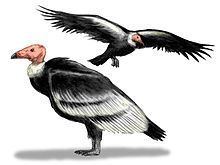Phylum Chordata Rank Family | ||
 | ||
Order Cathartiformes (disputed) Lower classifications Magnificent silver bird, Teratornis | ||
Teratorns (from the Greek Τερατορνις Teratornis, 'monster bird') are an extinct group of very large birds of prey that lived in North and South America from the Miocene to Pleistocene epochs. They include some of the largest known flying birds.
Contents
Taxonomy
Teratornithidae are related to New World vultures (Cathartidae, syn. Vulturidae).
So far, at least seven species in six genera have been identified:
Some cryptozoologists such as Ken Gerhard, and Mark A. Hall have expressed interest in teratorns as a possible explanation of anecdotal sightings of very large birds in Texas and Illinois and popularly known as Thunderbirds.
Description and ecology
Despite their size, there is little doubt that even the largest teratorns could fly. Visible marks of the attachments of contour feathers can be seen on Argentavis wing bones. This defies some earlier theories that modern condors, swans, and bustards represent the size limit for flying birds. The wing loading of Argentavis was relatively low for its size, a bit more than a turkey's, and if there were any significant wind present, the bird could probably get airborne merely by spreading its wings, just like modern albatrosses. South America during the Miocene probably featured strong and steady westerly winds, as the Andes were still forming and not yet very high.
T. merriami was small enough (relatively speaking) to take off with a simple jump and a few flaps. The fingerbones are mostly fused as in all birds, but the former index finger has partially evolved into a wide shelf at least in T. merriami, and as condors have a similar adaptation, probably in other species, too. Wing length estimates vary considerably but more likely than not were at the upper end of the range, because this bone structure bears the load of the massive primaries.
Traditionally, teratorns have been described as large scavengers, very much like oversized condors, owing to considerable similarity with condors. However, the long beaks and wide gapes of teratorns are more like the beaks of eagles and other actively predatory birds than those of vultures. Most likely teratorns swallowed their prey whole; Argentavis could technically swallow up to hare-sized animals in a single piece. Although they undoubtedly engaged in opportunistic scavenging, they seem to have been active predators most of the time. Teratorns had relatively longer and stouter legs than Old World vultures; thus it seems possible that teratorns would stalk their prey on the ground, and take off only to fly to another feeding ground or their nests; especially Cathartornis seems well-adapted for such a lifestyle. Argentavis may have been an exception, as its sheer bulk would have made it a less effective hunter, but better adapted to taking over other predators' kills. As teratorns were not habitual scavengers, they most likely had completely feathered heads, unlike vultures.
As in other large birds, a clutch probably had only one or two eggs; the young would be cared for more than half a year, and take several years to reach maturity, probably up to a dozen in Argentavis.
